A samurai sword experience. How you can practice basic sword moves, use a genuine, 400-year-old samurai sword to slice through tatami and learn about the 1,000 year-old samurai tradition.
All this while surrounded by exquisite samurai armour in a beautiful old machiya Kyoto townhouse.
Alongside shrines and temples, Mt. Fuji, cherry blossom, geisha, bullet trains, and sumo wrestling, Japan's ancient warriors - the samurai - are up there when it comes to iconic images of the country.
Download my Free "Best Kyoto Samurai Experiences" Guide:
UPDATE: Samurai Juku, the experience featured in this post, has closed for the forseeable future. However, Kyoto Samurai Experience offer a very similar and highly rated, 2-hour experience also in Kyoto. Links throughout this post have been updated to link to their service instead.
Samurai Sword Experience Kyoto
by Rob Dyer
Over 1,000 years of history
For over 1,000 years, the samurai have served as soldiers, bodyguards and peacekeepers.
Samurai first emerged as armed supporters of wealthy landowners during the Heian Period (794-1185). The word “samurai” roughly translates to “those who serve.”
The first written reference to them appears in the first imperial anthology of poems, the Kokin Wakashu, during the 10th Century. (The earliest example of the full Kokin Wakashu can be seen at the Tokyo National Museum.)
The Golden Age of Japanese culture
It was only after being shut out of power by the powerful Fujiwara clan, that many samurai left the imperial court to seek their own fortunes. Becoming the iconic characters we know today.
During the Higashiyama period, between the 15th-16th Centuries, there was considerable economic expansion in Japan. A burgeoning of creative arts and crafts known as Higashiyama culture, named after the district of the same name in Kyoto, rapidly developed.
It's often considered as a golden age for Japanese art, as samurai culture came under the growing influence of Zen Buddhism and wabi-sabi (beauty in simplicity).
Much of what is commonly seen today as traditional Japanese culture originated or refined in this period. Including the Japanese tea ceremony, landscape gardening, ikebana (flower arranging), drama, literature and sumi-e ink painting.
SEE ALSO: 3 Hidden Kyoto Walks To Get You Off The Beaten Path
What is a Samurai?
The samurai were a warrior caste in ancient Japan. For over 1000 years they served as soldiers, bodyguards, and peacekeepers.
While they were officially disbanded around 150 years ago, their skills, customs, and philosophy live on in modern society by people dedicated to keeping their legacy alive.
Katana is the Japanese word for "sword." They have a relatively thin, single-edge, curved blade.
Bushidō (lit: "way of the samurai") is the code of ethics of the samurai, very similar to the code of chivalry that European knights lived by. There are eight spiritual and philosophical elements, or virtues, to it: Righteousness, Courage, Compassion, Respect, Integrity, Honour, and Loyalty.
Iaidō is the Japanese martial art of drawing and wielding a sword. Originally, it was the practice of drawing a sword at speed from sitting when attacked unexpectedly, but it has evolved into a complete martial art. Samurai were trained in all aspects of combat.
Source: Samurai Juku
Samurai-Juku: a private Samurai school
If you're coming to Japan and you want to immerse yourself in its rich samurai culture and history, it is possible to attend a Samurai-Juku - or private samurai school.
Tucked away in the Higashiyama district, down a quiet side street in old Kyoto, away from the tourist crowds lies Samurai Juku.
It's here, nestled in the middle of a row of traditional wooden machiya townhouses, that you can learn about the ancient samurai culture and sword history. You can even practice using a 400 year old samurai sword with instruction from a master swordsman.
A beautiful old machiya townhouse
Samurai Juku was started by an Englishman, Dale Thomas, who first came to Japan in 2009. Having had a long-standing interest in Japan's samurai culture, Thomas purchased a beautiful old machiya town house, and former armoury.
He then set about converting it into a special place where anyone interested can learn about the samurai, and get their hands on a famous samurai sword.
The charming building lies just 10 minutes walk from Nijo Castle and Kyoto Imperial Palace.
Nijo was built in 1679, during the Tokugawa shogunate. The Imperial Palace is the former ruling palace of the Emperor of Japan, now acting as the Emperor's official residence in Kyoto.
On the ground floor is Usagi Juku, a space dedicated to continuing the tradition of making o-yoroi samurai armour from the Heian era, known for its decorative silk braids. Here, colourful displays of the armour can be viewed.
Nicely setting the scene for the samurai school on the floor above.
A journey back in time
Samurai Juku offers an experience where you can participate in a small part of samurai culture.
Participants can practice basic sword moves, use a real samurai sword to slice through a roll of tatami and learn about the 1,000 year-old samurai tradition. But before we can start, I need to look the part. Time to change clothes.
I put on a pair of white cotton tabi socks. The type with the big toe separated from the others toes (designed to be worn with traditional footwear). Then an impressive kimono and hakama jacket - just like a samurai.
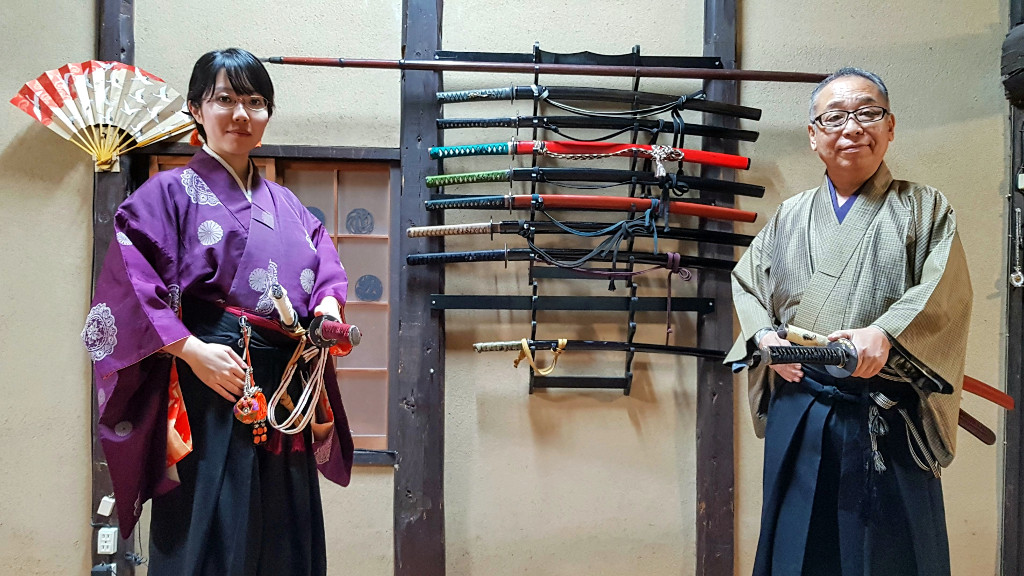
Samurai-Juku Manager Chihiro Wada and master swordsman Akihiko Kawata
If you're not used to wearing traditional Japanese clothing everyday, then this alone significantly changes your appreciation of what follows. I'm now starting to feel the part.
I slowly, carefully climb the wooden stairs to the former attic, now converted into a dojo - the learning space.
It's here that my journey back in time begins.
Modern western clothing is so geared towards comfort and ease of movement. If you were to wield a sword and practice movements and swordplay, it would be pretty straightforward, if somewhat incongruous.
Of course, donning the kimono and hakama set, for those unused to wearing them on a regular basis, introduces its own layer of learning how to move effectively (and safely).
Book Your Own Samurai Experience
Meeting a master swordsman
I'm introduced to Samurai-Juku's Manager, Chihiro Wada and Akihiko Kawata, a master swordsman. Both of whom are also enrobed in the traditional clothing. I now truly feel like I have stepped back in time.
With a background in cultural anthropology and a passion for Japanese history, Wada-san clearly enjoys sharing her culture with people from other countries. She introduces the history of swords in Japan, and the large role they have played in the history and cultural development of the country.
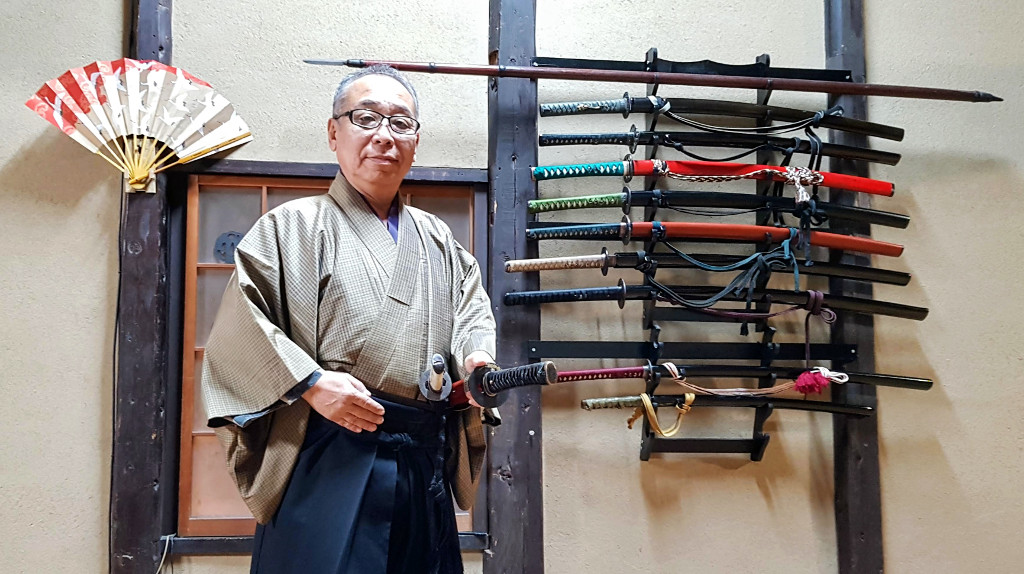
Akihiko Kawata comes from a 500-year-old samurai family
A 500 year-old Samurai family
Coming from a 500-year-old samurai family, Akihiko Kawata has practiced the art of Japanese swordplay all his life. He has attained the honoured title of renshi, which is far above black-belt level, and has won many awards at the highest competitions in Japan.
With interpretation into English from Wada-san, Kawata-san gives a performance of Iaido.
It's beginning to dawn on me what a privilege it is to have the chance to receive first-hand instruction from an Iaido master.
Now it's my turn.
400 year-old Samurai sword cutting through paper
Before handing me my own, in order to demonstrate just how sharp a 400 year old samurai sword can still be, Kawata-san took a sheet of paper in his left hand and held it aloft.
Holding the katana in his right hand, he gently drew the glistening blade across the edge of the white sheet.
It effortlessly sliced through the paper. He did it a second, third and fourth time in quick succession. Each time the paper wilted more as the weight of the sheet shifted with the shreds left hanging.
Wielding a Samurai sword
Before I knew it, I was wielding my own samurai sword.
Kawata-san begins guiding me through the basics such as how to hold the long, slightly curved sword and the best (and worst) positions in which to hold it if I were in a fight to the death.
Thankfully, today is merely for learning. Which is just as well, as when we get to the sheathing and unsheathing of the blade, I struggle not only to get the blade in the sheath but am in constant fear of losing several fingers during the process!
Book Your Own Samurai Experience

Taking instruction from master swordsman Akihiko Kawata
Trying not to sever my body parts
Taking the sheath in my left hand (I am right-handed) I'm told to rest the backside of the blade on the back of my hand, just between my thumb and forefinger. Then, with my right hand, I am to draw the blade forwards and, supposedly, just let the (very pointed) tip gently drop into the top of the sheath in my left hand.
The only problem is, my right arm doesn't appear to be long enough. I'm supposed to be able to comfortably, and safely, draw back the sword far enough so that it easily slips into the sheath.
It takes me several attempts. During each of which I'm convinced I'll cut myself (thoughts of that shredded piece of paper from earlier transfixed in my mind). Although my efforts were awkward to say the least, thankfully I managed not to sever any of my body parts.
Although it could hardly be said I'd 'mastered' the unsheathing/sheathing element, it was time to move onto some of the basic swordplay moves.
What was becoming clearer as I progressed through this session was how experiential the learning is. Kawata-san would demonstrate a stance, movement or technique (each time translated by Wada-san, who was also happy to take questions along the way), but as he did so, he explained why particular moves are the way they are.
For example, if you held your sword at a specific angle, it was the angle shown because that gave you certain tactical advantages mid-combat.
Some of the positions frequently used by samurai seen in the movies (holding the sword high above one's head, with the blade facing downwards, for example) are more for their visual impact on screen than any practical, real world application.
Once Kawata-san sagely explained why these moves were impractical in the context of genuine combat, it instantly made you realise just how daft some of them truly were.
Download my Free "Best Kyoto Samurai Experiences" Guide:
The truth about Japanese 'throwing stars'
Another detail I was quite surprised by was seeing what the so-called 'throwing stars', used by samurai (and made more famous by their ninja counterparts), were really like.
Shuriken as they are called in Japanese, literally means 'hidden hand blade'. Hence, these throwing blades were concealed weapons.
Shuriken, the edges of which were often sharpened so they could penetrate skin and open arteries, came in a variety of forms. Although often referred to as 'throwing stars' the major types of shuriken are the bō shuriken (stick shaped shuriken) and the hira (flat) or shaken/kurumaken (wheel) shuriken.
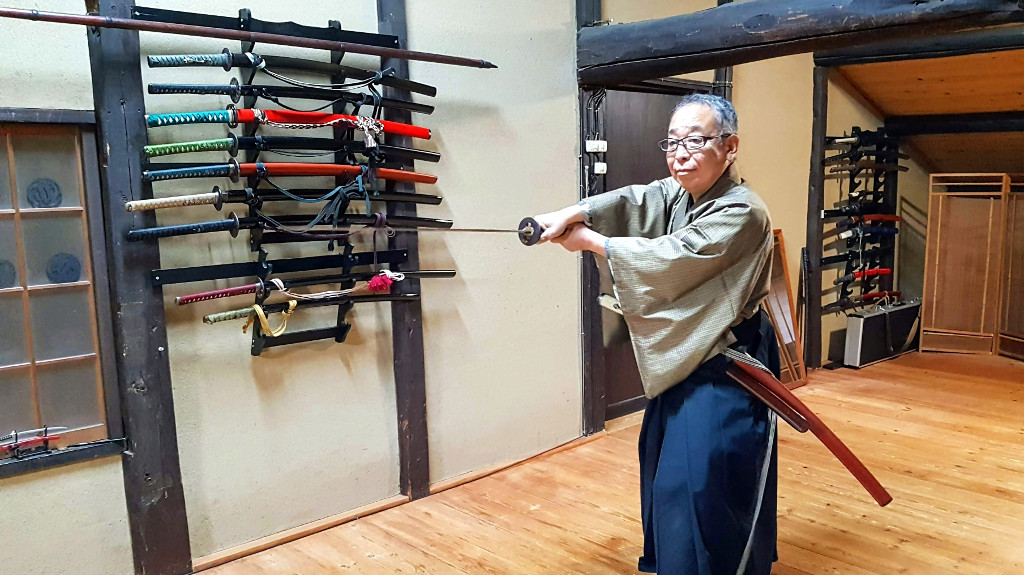
Several of the samurai swords are 400+ years old
Those often used by samurai are the bō shuriken - straight iron or steel spikes. Resembling large nails or needles, these were kept hidden in the cuffs of a samurai's kimono.
They were thrown in a number of ways, but each uses the technique of allowing the blade to slide out of the hand through the fingers in a smooth, controlled motion.
Training over, it was time to take all I'd learned so far, step outside and do some cutting.
Feeling the spirit of the Samurai
Up until now, I'd been using a replica samurai sword. Which was nerve-wracking enough. For the climax of the experience, that is replaced by one of the master's real antique samurai swords. The one I used was around 400 years old.

Kawata-sensei gives clear, specific instructions
At the rear of the machiya is a small courtyard garden. When the weather is good, it's here where you get the chance to cut through a rolled tatami mat. (If it's raining, the cutting takes place inside the dojo.)
Mats are rolled up tightly and placed vertically on a wooden stand.
The way to wield a samurai sword is not with brute force. As the blade is so utterly sharp it's more about technique than power. Kawata-san gives clear, specific instructions. There's actually a zen-like simplicity to it.
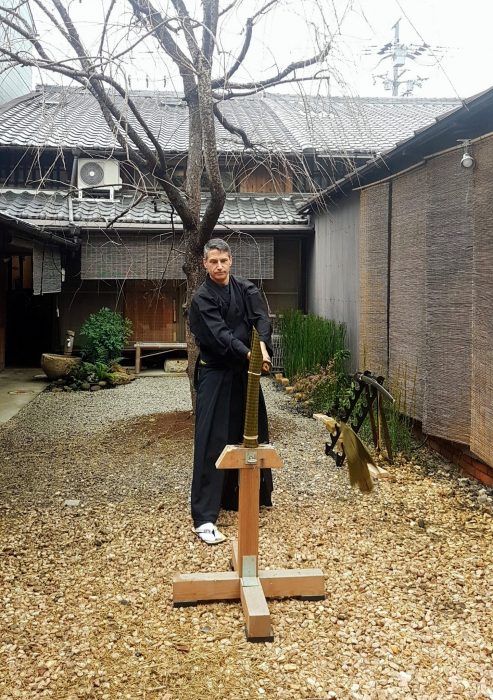
Technique is more important than raw power
Beginning with the sword held above one's head, you turn the blade to a 30° angle. This is the optimum angle for slicing with the minimum of effort. Focusing on a swift, fluid cutting motion, the blade cleanly passes through the rigid, rolled tatami mat.
You do, however, need to apply a certain amount of weight behind the strike. The first time I attempt it, whilst I have the correct angle, the blade stops halfway through the mat. I need to apply more oomph next time!
As soon as I corrected that it was surprisingly easy (and satisfying) to cut through the mat.
Posing for a few photos (Samurai Juku include guest photos on their blog), my time at Samurai Juku had come to an end.
Book your own Kyoto Samurai Experience
Book through our partner Viator
An experience of a lifetime
As someone keen on experiential learning, the chance to get hands-on with a real, 400-year old samurai sword, in an authentic machiya townhouse, really is something I'll never forget.
Trust me, no amount of academic study, reading texts or watching videos, will convey the understanding you get from unsheathing an unfathomably sharp samurai sword with your own hands.
It's just something you have to experience for yourself.
For anyone interested in samurai culture or the history of swords in Japan, this really is an experience of a lifetime.
Location Map

About the Author
A writer and publisher from England, Rob has been exploring Japan’s islands since 2000. He specialises in travelling off the beaten track, whether on remote atolls or in the hidden streets of major cities. He’s the founder of TheRealJapan.com.
If you enjoyed this article please share this image:
Resources
Download my Free "Best Kyoto Samurai Experiences" Guide:
Further Related Reading
3 Magical Day Trips From Kyoto To Escape The Crowds
5 Exclusive Japanese Knife Experiences With Traditional Artisans
5 Fascinating Lessons Films Teach Us About Japanese Culture
Experience A Beautiful Japanese Tea Ceremony in Kyoto
Finding Peace – 5 Extraordinary Zen Meditation Experiences
Japanese Knives: 600 Years of Craftsmanship
Seike Yuba (Tofu Skin) Restaurant, Kyoto
Stardust Vegan Cafe & Boutique, A Kyoto Oasis
Top 6 Best Rated Kyoto Cycling Tours
Yoshimune: Authentic Japanese Kitchen Knives
How to Travel in Japan Without Speaking Japanese
If you want to travel to Kyoto but don't speak Japanese my book can help you. Find out more HERE.
Feedback and questions welcome - please leave a comment below.

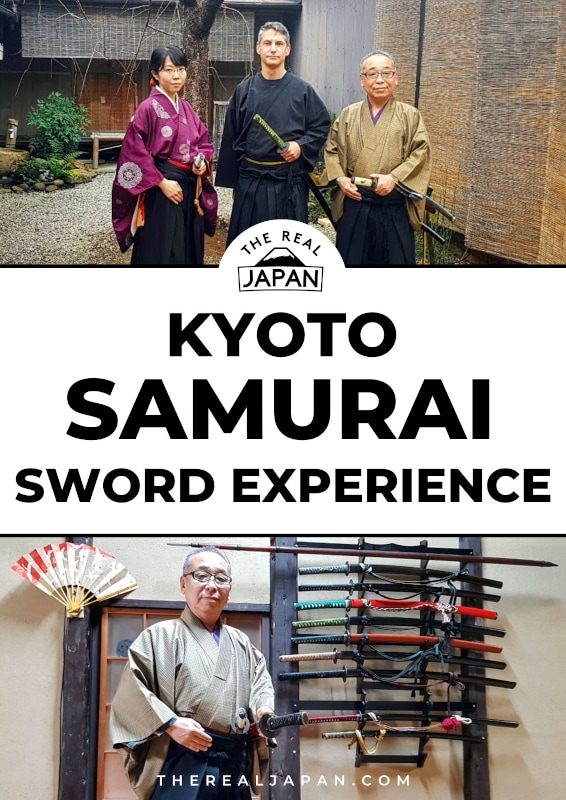





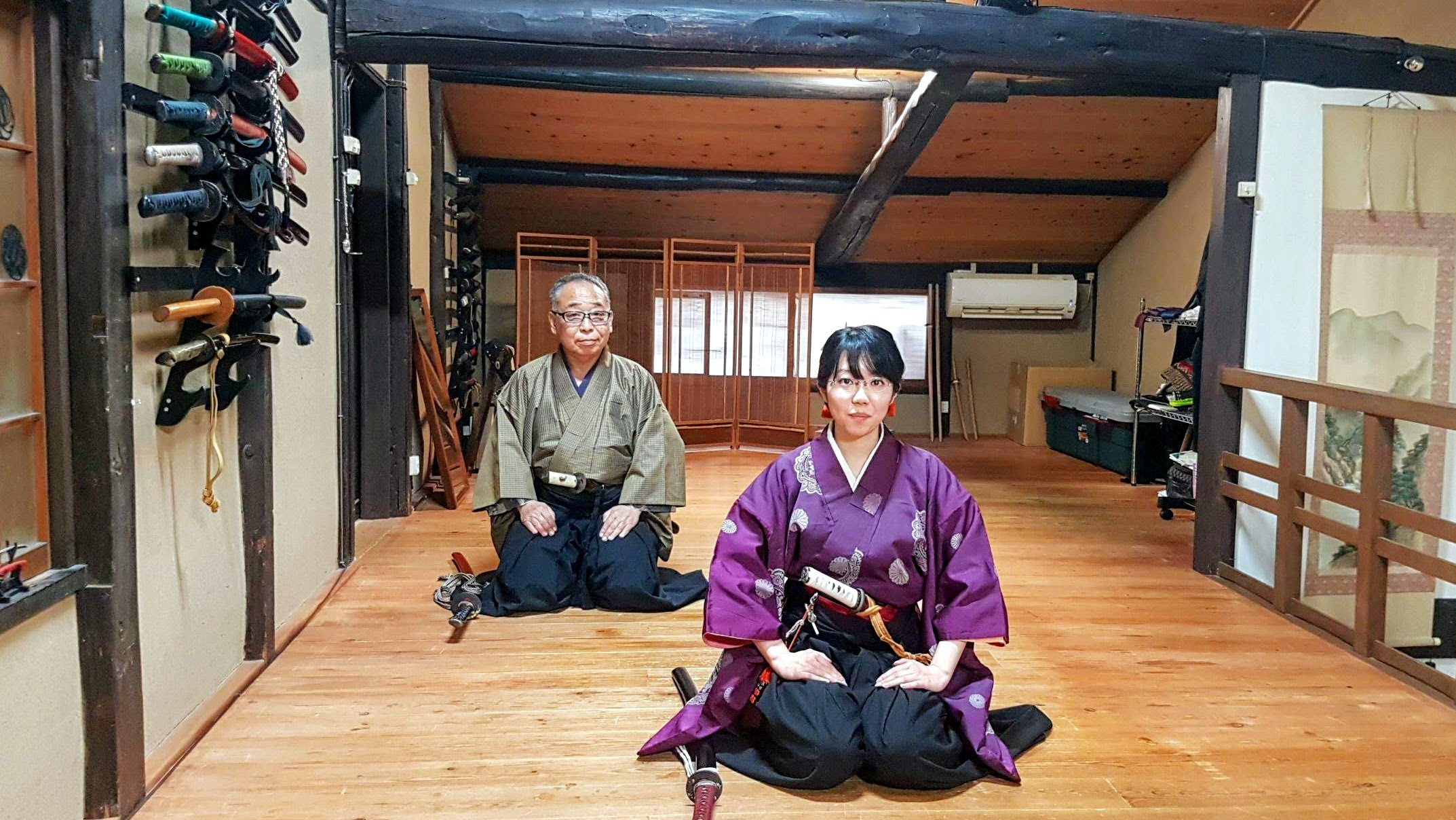

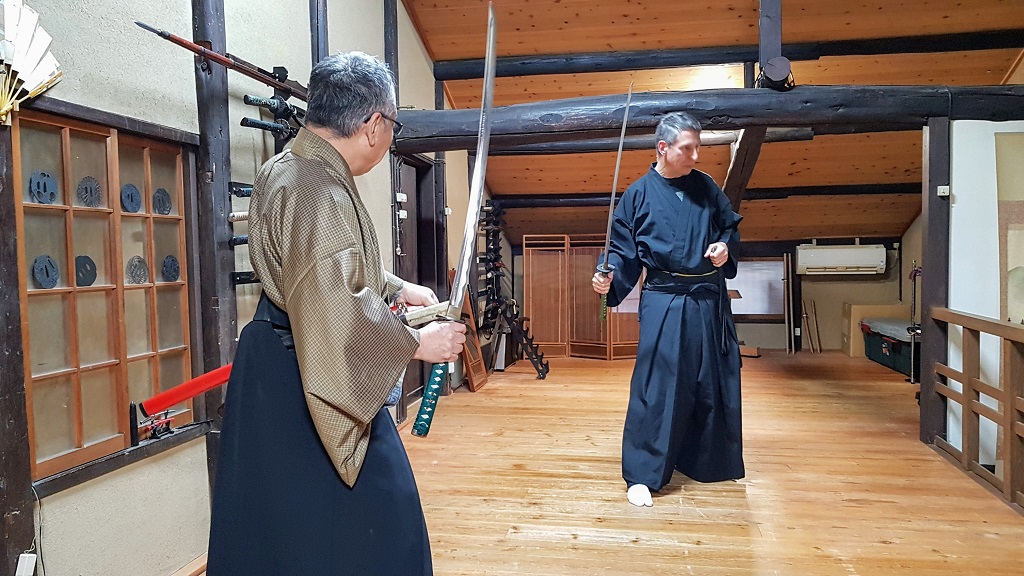


This immersive samurai sword experience sounds incredible! A must-do for history lovers!
Congratulation very interesting !!!!
Thanks Andrey – glad you enjoyed it.
You might also find this post of interest…
https://www.therealjapan.com/japanese-knives/
Hello sir, I come form Thailand. I am interested story of samurai long time since young guy because sword is beautiful and look strong when in the hand and fighting in the war. I read everything on your website, it’s very good story. I hope one day I go to Japan and go to Kyoto for see to you. bye bye
Welcome from Thailand Tulaporn! Good to know my stories of my travels in Japan and this samurai experience in Kyoto have reached you.
I hope that you get to Kyoto before too long and maybe have such an experience for yourself.